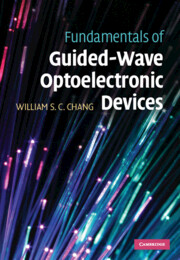4 - Time dependence, bandwidth, and electrical circuits
Published online by Cambridge University Press: 25 January 2011
Summary
In order to create the electro-optical effects discussed in Chapter 3, a voltage is applied to the electrodes of the devices through electrical circuits to produce the electrical field. Most of the voltages that control the modulation, switching and signal processing functions are time varying, their frequency spectra range from MHz to tens of GHz. In analog applications, it is the frequency response of the device that is important whereas in digital applications, it is the time response of the device to a voltage (or current) pulse that is important. Pulse modulators are usually large signal devices. The time response of devices such as intensity modulation in a Mach–Zehnder or electro-absorption modulator is usually non-linear with respect to the magnitude of the applied voltage. Thus it is difficult to give a general discussion of the time response of electro-optical devices. However, pulses can be represented as a summation of their frequency components. Section 4.2.6 discusses the relation between frequency response and pulse propagation. Therefore, only the response of the devices to a time harmonic small voltage signal at different frequencies will be discussed in this book.
There are two major causes for frequency variation of the small signal response of electro-optical devices.
(1) The voltage across the device supplied by the electrical circuit is frequency dependent. For example, when the electrical source has a time harmonic variation, the fraction of the source voltage that appears across the device is frequency dependent. There is an electrical bandwidth of the voltage produced by the circuit driving the optoelectronic device.
[…]
- Type
- Chapter
- Information
- Fundamentals of Guided-Wave Optoelectronic Devices , pp. 97 - 116Publisher: Cambridge University PressPrint publication year: 2009



